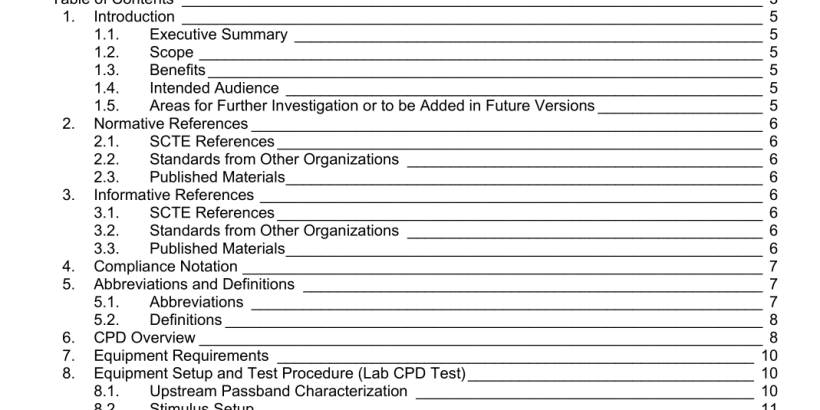ANSI SCTE 109-2019 pdf download.Test Procedure for Common Path Distortion (CPD)
6. CPD Overview
Common path distortion is a well-known impairment that affects a cable network’s return path. CPD comprises nonlinear distortions other than those generated in active devices, and which appear in the upstream spectrum. While CPD can include higher order distortions, second and third order distortions are generally the most prevalent. In operating cable networks, CPD is usually in the class of composite distortions, similar to composite second order (CSO) and composite triple beat (CTB) distortions generated in active devices. CPD occurs when downstream RF signals pass through a diode-like nonlinearity, typically at interfaces where corrosion has formed in the signal path common to the downstream and upstream spectrums. The resulting oxide layer behaves somewhat like a semiconductor, and can be just a few molecules thick, making it fragile and susceptible to being affected by wind, vibration, temperature changes, and so on. All of the aforementioned, in addition to varying downstream RF signal levels, complicate location and troubleshooting of CPD sources. Some of the CPD generated by the diode-like nonlinearity occurs in the downstream and some in the upstream. The downstream CPD appears on the same frequencies as existing downstream composite distortions (CSO and CTB) and cannot be easily differentiated from CSO and CTB produced by active devices. 1 What is of concern in this document is the distortions that appear in the upstream spectrum, which propagate toward the node and headend/hub. When the cause of the CPD is identified and repaired, the CPD that was occurring in both directions will be eliminated.
The corrosion “diode” that produces CPD doesn’t always behave in a predictable manner, as one might expect from an actual diode. As such, CPD can appear as second order beats, third order beats, or a combination of second and third order beats. The amplitude of those beats across the return spectrum can vary significantly, too. In cable networks that carry mostly analog TV signals in the downstream, the CPD beat clusters appear every 6 MHz (8 MHz in European systems). Figure 1 shows an example of second and third order CPD in an older mostly-analog system. The second order beats appear at 6 MHz and 12 MHz (both partially obscured by ingress), and 18 MHz, 24 MHz, 30 MHz, 36 MHz (partially obscured by the cable modem signal), and 42 MHz. Third order beats appear 1.25 MHz below and 1.25 MHz above each second order beat.
A procedure also is included to adapt and extend the lab test method to a live cable network, involving the injection of downstream carriers at certain frequencies in the headend or hub, and measuring an upstream beat (or beats) at a headend/hub upstream test point. The examples in this document focus on a 5 MHz to 42 MHz upstream spectrum, although other upstream bandwidths can be used (e.g., 5 MHz to 85 MHz). The methods described in this document can be adapted to any choice of upstream spectrum bandwidths without materially impacting the results.
This document describes standard methodology that can be used for characterizing CPD in a lab and field environment. In particular, the lab method is unique in that it supports CPD characterization of single-port devices. An extension of the lab method intended for use in a live cable network can be thought of as treating the entire network as a single-port “black box” of sorts. The procedures in this document can augment other CPD test and measurement techniques used by the cable industry.ANSI SCTE 109-2019 pdf download
